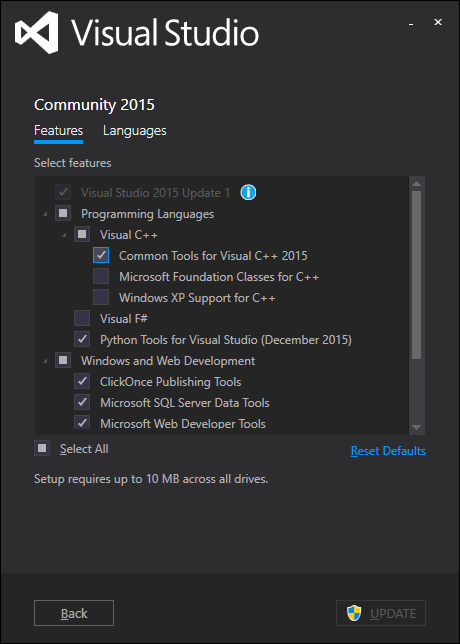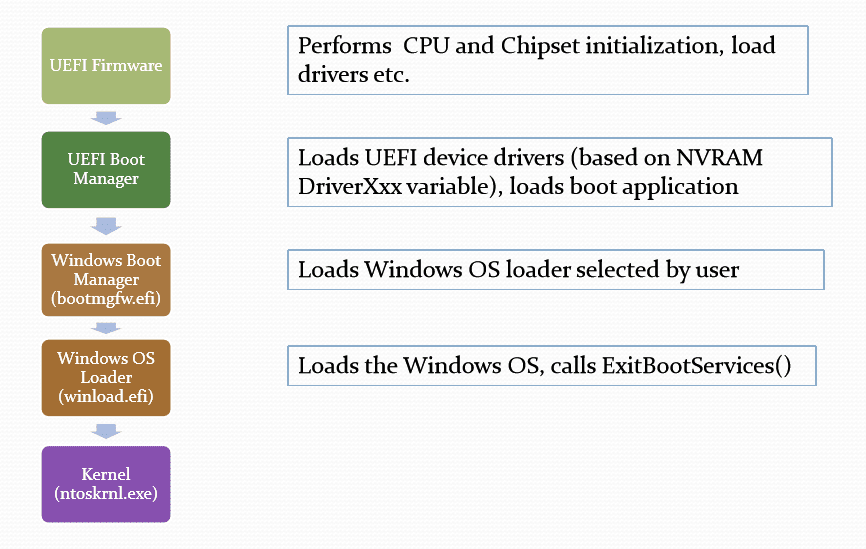早期Legacy BIOS會在DOS環境下, 透過指令方式, 或集結成批次檔 *.bat 以完成特定的自動化需求; 現在推動UEFI環境, 這是Built-in的 EFI shell, 要自動化也是需要批次檔 *nsh
當系統開機到 EFI shell時, 此時嵌入式作業系統會透過搜尋已定義好的path 找尋此檔 startup.nsh, 所以基本上來說Startup.nsh相當於DOS/Windows環境下的autoexec.bat,當跑完這個startup script之後, 會顯示如下的指令提示介面: (翻譯引用自Intel文件:Basic Instructions for Using the Extensible Firmware Interface (EFI))
Shell>
下表引用自UEFI和Legacy BIOS的差異
| Legacy BIOS | UEFI | |
| 發明年代 | 1975 by IBM | 2002 by Intel |
| 程式語言 | 組合語言 | C語言 |
| CPU mode | 16-bit mode(Real mode) | 32/64-bit mode(Flat mode) |
| 記憶體定址空間 | ~1 MB | >4 GB |
| 支援硬碟分割格式 | MBR | GPT |
| 支援硬碟最大容量 | ~2 TB | ~9 ZetaBytes |
| 支援硬碟主分割區數量 | 4 | 128 |
| Boot Speed | 慢 | 快 |
| Boot Manager | Boot loader in MBR | Boot loaders in ESP |
| 硬體擴充方式 | Option ROM | EFI driver |
| 硬體資源控制 | Interrupt | Protocol/Driver |
| 安全機制 | TPM | Secure Boot |
| VGA BIOS | VBIOS | GOP |
| Bootable USB Flash drive | DOS | EFI Shell |
統一可延伸韌體介面(Unified Extensible Firmware Interface, UEFI)是一種個人電腦系統規格,用來定義作業系統與系統韌體之間的軟體介面,作為BIOS的替代方案。可延伸韌體介面負責加電自檢(POST)、連繫作業系統以及提供連接作業系統與硬體的介面。(參考自wiki)
可擴展韌體介面在軟體堆疊裡的位置
EFI開機管理員與 EFI drivers的溝通方式
EFI/UEFI Shell Command
列出EFI/UEFI 裡面 EFI Shell界面支持的命令。
對這些命令無法執行或出錯,在EFI shell提示符下輸入help命令。
可以使用的一些命令如下:
“Boot Commands — EFI Shell”.
“Configuration Commands — EFI Shell”.
“Device, Driver, and Handle Commands — EFI Shell”.
“Filesystem Commands — EFI Shell”.
“Memory Commands — EFI Shell”.
“Shell Navigation and Other Commands — EFI Shell”.
“Shell Script Commands / Programming Constructs — EFI Shell”.
| Command | Description |
|---|---|
| Boot Commands — EFI Shell.
Commands related to nPartition booting. n分區啟動的相關命令 |
|
| autoboot | Set/view autoboot timeout variable. |
| bcfg | Display/modify the driver/boot configuration. |
| boottest | Set/view BootTest bits. |
| dbprofile | Display/modify direct boot profiles for use by lanboot. |
| lanboot | Boot over the LAN. |
| reconfigreset | Reset the system (nPartition) for reconfiguration; the nPartition remains inactive, in the shutdown for reconfig state. |
| reset | Reset the system (nPartition). |
| search | Connect drivers for bootables devices. |
| Configuration Commands — EFI Shell.
Commands for changing and retrieving system (nPartition) information. |
|
| acpiconfig | Set/view ACPI configuration mode. |
| cellconfig | Deconfigure/reconfigure cells. (Set cell use-on-next-boot values.) |
| cpuconfig | Deconfigure/reconfigure processors and processor cores.. |
| date | Display the current date or set the date of the system (nPartition). |
| dimmconfig | Deconfigure/reconfigure memory (DIMMs). |
| err | Display/change the error level. |
| errdump | View/clear logs. |
| fru | View FRU data. |
| info | Display hardware information. |
| monarch | Set/view a monarch processor. |
| palproc | Make a PAL call. |
| romdrivers | Enable/disable PCI expansion ROM drivers. |
| rootcell | Set/view preferred root cells. (Set nPartition core cell choices.) |
| salproc | Make a SAL call. |
| tftp | Performs TFTP operation to a bootp/DHCP enabled Unix boot server. |
| time | Display the current time or set the time of the system (nPartition). EFI time is set and presented in GMT (Greenwich mean time). |
| variable | Save/restore specific EFI variables. |
| ver | Display the version information. |
| Device, Driver, and Handle Commands — EFI Shell.
Commands for managing devices, drivers, and handles. |
|
| baud | View serial port com settings. |
| connect | Bind a driver to a device. |
| dblk | Hex dump of BlkIo devices. |
| devices | Display devices managed by EFI drivers. |
| devtree | Display tree of devices. |
| dh | Dump handle info. |
| disconnect | Disconnect driver(s) from device(s). |
| drivers | Display list of drivers. |
| drvcfg | Invoke the Driver Config Protocol. |
| drvdiag | Invoke the Driver Diagnostics Protocol. |
| guid | Dump known GUID IDs. |
| lanaddress | Display MAC address. |
| load | Load EFI drivers. |
| map | Map shortname to device path. |
| openinfo | Display the open protocols for given handle. |
| pci | Display PCI devices or PCI function configuration space. |
| reconnect | Reconnect driver(s) from a device. |
| unload | Unload a protocol image. |
| Filesystem Commands — EFI Shell.
Commands for managing files, directories, and attributes. |
|
| attrib | Display/change the attributes of files/directories. |
| cd | Update/view the current directory. |
| comp | Compare the contents of two files. |
| cp | Copy one or more files/directories to another location. |
| edit | Edit an ASCII or UNICODE file in full screen. |
| eficompress | Compress infile and write to outfile. |
| efidecompress | Decompress infile and write to outfile. |
| hexedit | Edit a file, block device, or memory region using hex. |
| ls | Display a list of files and subdirectories in a directory. |
| mkdir | Create one or more directories. |
| mount | Mount a filesystem on a block device. |
| rm | Delete one or more files/directories. |
| setsize | Set the size of a file. |
| touch | Update time of file/directory with current time. |
| type | Display the contents of a file. |
| vol | Display volume information of the file system. |
| Memory Commands — EFI Shell.
Commands for listing and managing memory, EFI variables, and NVRAM details. |
|
| default | Set the default NVRAM values. |
| dmem | Dump memory or memory mapped IO. |
| dmpstore | Display all EFI variables. |
| memmap | Display the memory map. |
| mm | Display/modify MEM/IO/PCI. |
| pdt | View/clear nPartition or cell memory page deallocation table (PDT). |
| Shell Navigation and Other Commands — EFI Shell.
Commands for basic EFI Shell navigation and customization. |
|
| alias | Set/get alias settings. |
| cls | Clear the standard output with an optional background color. |
| exit | Exit EFI Shell environment. |
| getmtc | Display current monotonic counter value. |
| help or ? | Display help. |
| mode | Display the mode of the console output device. |
| set | Set/Get environment variable. |
| xchar | Turn on/off extended character features. |
| Shell Script Commands / Programming Constructs — EFI Shell.
EFI shell-script commands. |
|
| echo | Echo message to stdout or toggle script echo. |
| else | Script-only: Use with IF THEN. |
| endfor | Script-only: Delimiter for FOR loop construct. |
| endif | Script-only: Delimiter for IF THEN construct. |
| for | Script-only: Loop construct. |
| goto | Script-only: Jump to label location in script. |
| if | Script-only: IF THEN construct. |
| input | Take user input and place in EFI variable. |
| pause | Script-only: Prompt to quit or continue. |
| stall | Stall the processor for some microseconds. |
其他指令
STALL (以微秒為單位的延遲)
Note:
1. STALL in emulation NT environment will sleep for ‘microseconds’.
2. STALL in some other platforms will wait for ‘microseconds’.
3. Microseconds is in decimal units.
Examples:
Shell> stall 1000000 //表示Stall for 1000000 uS




![[轉] 筆記更新 – Windows顯示驅動 (WDDM) 編程初步 [轉] 筆記更新 – Windows顯示驅動 (WDDM) 編程初步](http://4.bp.blogspot.com/-m7XnCOK5o1o/XUf0Oo4ce8I/AAAAAAAALf0/DCxdz_nDM4g3_rVfjI08l2ye7E9mGVikQCLcBGAs/s1600/WDDM-Frame.png)



